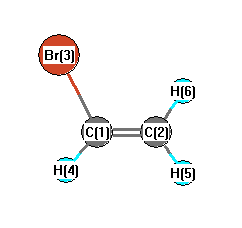Geometric Data

Point Group Cs
Internal coordinates
distances (r) in Å, angles (a) in degrees, dihedrals (d) in degrees
These cartesians were determined using some assumed coordinate values.
Cartesians
| Atom |
x (Å) |
y (Å) |
z (Å) |
| C1 |
1.1945 |
0.5299 |
0.0000 |
| C2 |
2.2147 |
-0.3259 |
0.0000 |
| Br3 |
-0.6032 |
-0.0343 |
0.0000 |
| H4 |
1.3131 |
1.6029 |
0.0000 |
| H5 |
3.2261 |
0.0530 |
0.0000 |
| H6 |
2.0500 |
-1.4016 |
0.0000 |
Atom - Atom Distances 
Distances in Å
| |
C1 |
C2 |
Br3 |
H4 |
H5 |
H6 |
| C1 |
|
1.3316 | 1.8841 | 1.0796 | 2.0868 | 2.1124 |
| C2 |
1.3316 |
|
2.8330 | 2.1291 | 1.0800 | 1.0882 |
| Br3 |
1.8841 | 2.8330 |
|
2.5204 | 3.8303 | 2.9848 |
| H4 |
1.0796 | 2.1291 | 2.5204 |
|
2.4621 | 3.0935 |
| H5 |
2.0868 | 1.0800 | 3.8303 | 2.4621 |
|
1.8705 |
| H6 |
2.1124 | 1.0882 | 2.9848 | 3.0935 | 1.8705 |
|
Calculated geometries
for C
2H
3Br (vinyl bromide).
Experimental Bond Angles (degrees) from cartesians 
| atom1 |
atom2 |
atom3 |
angle |
|
atom1 |
atom2 |
atom3 |
angle |
| C1 |
C2 |
H5 |
119.472 |
|
C1 |
C2 |
H6 |
121.284 |
| C2 |
C1 |
Br3 |
122.587 |
|
C2 |
C1 |
H4 |
123.683 |
| Br3 |
C1 |
H4 |
113.729 |
|
H5 |
C2 |
H6 |
119.244 |
Bond descriptions
Examples: C-C single bond, C=C, double bond, C#C triple bond, C:C aromatic bond
| Bond Type |
Count |
| C=C |
1 |
| C-Br |
1 |
| H-C |
3 |
Connectivity
| Atom 1 |
Atom 2 |
| C1 |
C2 |
| C1 |
Br3 |
| C1 |
H4 |
| C2 |
H5 |
| C2 |
H6 |









